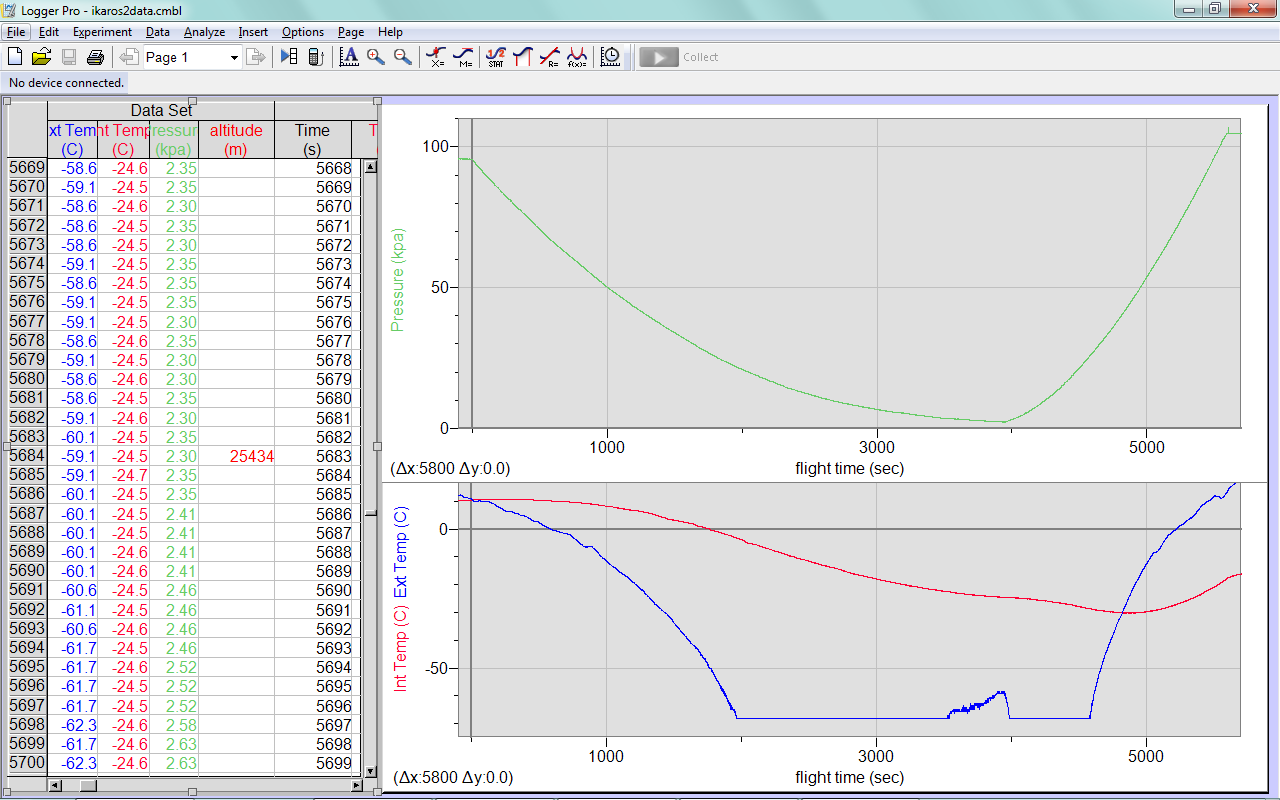Ikaros 2
Near-Space Balloon Mission
Around 8am on Friday, April 15th, we launched Ikaros II equipped with several video cameras, temerature and pressure sensors, and an APRS GPS transmitter from Morgan Territory Regional Park, east of the San Francisco Bay Area. After ascending for an hour and 6 minutes, the balloon burst at 83,772 feet, nearly 16 miles above the Central Valley. With a malfunctioning tracking system, we were afraid the equipment was lost, but after falling for 27 minutes, a 6-year-old girl in Turlock, California saw it parachute to the ground in front of her house. The family called us, and before noon we were able to pick up Ikaros II 57 miles ESE of the launch site.
Photos via flickr:
Flight Info
- Launch Date
- April 15, 2011 8:01am PDT
- Flight Duration
- 1 hour 33 mintues
- Ascent Time
- 66 minutes
- Descent Time
- 27 minutes
- Distance Traveled
- 92 km (57 miles)
- Initial Ascent Rate
- 4.8 m/s (950 ft/min)
- Final Ascent Rate
- 6.6 m/s (1300 ft/min)
- Maximum Descent Rate
- 39 m/s (88 mph)
- Impact Speed
- 7.6 m/s (17 mph)
- Maximum Altitude
- 25,534 m (83,772 ft)
- Lowest Temperature
- < -60° (-76°F)
- Lowest Pressure
- 2.3 KPa (.02 atmospheres)
Please read the press release for an overview of the project. Additional details are included below.
Project Details
Balloon and inflation
We bought a 1300 gram balloon from Army surplus, filled it with enough helium to lift 60 Newtons. We cut off the skirt because it was unnecessary weight. We bought a regulator to use to measure the amount of helium we put in the balloon. However, the regulator limited the flow too much, so we didn’t use them. Instead we used party balloon filling regulators which release helium when bent.
We used two helium tanks which combined into one tube with a barbed plastic T. This allowed us to fill the balloon quicker.
We used a spring powered force meter to measure the number of Newtons the balloon was applying to the payload. The load was out of the spring scale's range, so we estimated lift with various heavy objects in a milk crate--something to plan better next year, along with remembering a wrench for the regulators. We used a spreadsheet designed by Dr. Piccioni and last year's students to find the number of Newtons our balloon needed to lift. It took about 20 minutes to fill because we used the dual tank system with a better piping system than the year before when it took over an hour.



Parachute
Apparatus to deploy parachute and retract balloon after balloon burst


Data collection
We used a Vernier LabQuest with gas pressure and internal and external temperature sensors. The balloon cam was mounted to this, the top package. This was the only 808 camera with additional batteries (3 AA lithium) allowing it to record till the memory card was full after balloon burst and parachute deployment.



Video
We used a Go Pro HD ($300) and a Flip mino ($60 discontinued.) We then put them in a 4x4x6-inch box surrounded by custom-cut Styrofoam. We also attached three 808#3 keychain cameras ($15 each) to the outside of the boxes in their own styrofoam/metal-tape enclosures.

Tracking
The tracking system consisted of a GPS connected to an amateur radio frequency APRS transmitter with a quarter-wave ground plane antenna.
- GPS
- Garmin eTrex Legend
- Product discontinued: $65 used
- 132g
- 2 AA Energizer Ultimate Lithium Batteries
- $15 for 8
- 29g
- Garmin Serial Port Cable
- shortened to 10 inches
- $28
- 108g
- Transmitter
- Micro-Trak 8000 FA
- $190
- 52g
- 8 AA Energizer Ultimate Lithium Batteries http://data.energizer.com/PDFs/l91.pdf
- $15 for 8
- 116g
- Serial F/F null modem cable
- to program transmitter, not sent aloft
- $5
- 8 AA Cell Battery Holder
- $2
- Battery clip
- $1
- Antenna
- Quarter-wave ground-plane: instructions
- SO-239 mount
- $2
- PL-259 M-M adaptor
- SO-239 to SMA adaptor cable
- 4 very small nuts and bolts
- 10 feet coated 12-gauge solid copper wire
- Antenna support
- 5 fiberglass tent poles
- $10 for 4
- 3/8-inch dowel rod
- 2 zip ties
- 1-inch PVC pipe
- Pipe elbows
- 4x6x8-inch corrugated cardboard box
- $1
- Styrofoam




Launch Site
Morgan Territory Regional Preserve Staging Area, southeast of Mt. Diablo

